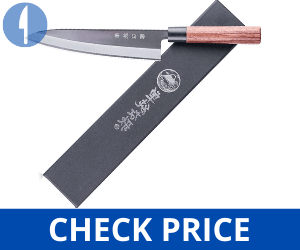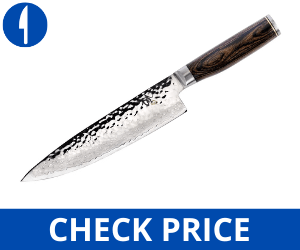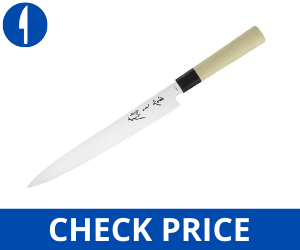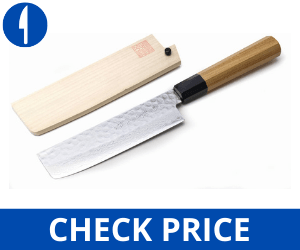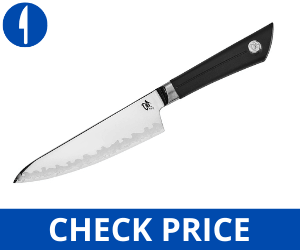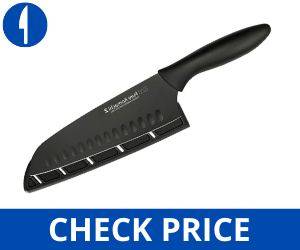It doesn’t matter whether you are a chef at a five Star continental restaurant, or you just want to make sushi for your family, best Japanese knives are still the smartest investment in your kitchen fleet.
If you are looking to get a true Japanese knife, here we have organized a list of the 20 best Japanese knives that you should never miss.
Let’s find out what you are paying for!
Top 3 Picks of Best Japanese Knives

- Material: Alloy Steel
- Size: 8 inches
- Weight: 12 ounces
- Dimensions: 15.2 x 2.8 x 1.46 inches
- Manufacturer: Famcute

- Material: Alloy
- Size: 10 inches
- Weight: 4.8 ounces
- Dimensions: 12.22 x 0.06 x 1.75 inches
- Manufacturer: Yoshihiro
Best Japanese Knives at a Glance
| IMAGE | PRODUCT | SHOP |
|---|---|---|
|
Overall Best

|
FAMCÜTE 8″ Pro Japanese Chef Knife
|
Shop Here |
|
Best Value

|
Shun Sora 6″
|
Shop Here |
|
Long Lasting

|
Yoshihiro VG-10 46 Layers Damascus Gyuto
|
Shop Here |
|
Best Durable
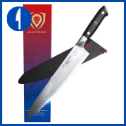
|
DALSTRONG Chef’s Knife – 9.5″
|
Shop Here |
|
Best Comfortable

|
Yoshihiro VG-10 46 Layers Japanese Knife
|
Shop Here |
|
Easy To Sharp
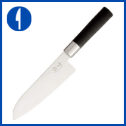
|
Kai Wasabi Black Santoku Knife, 6.5″
|
Shop Here |
|
Vegetable

|
Mercer Culinary Asian Collection Yanagi Sashimi
|
Shop Here |
|
All Rounder

|
Shun Cutlery Premier 8”
|
Shop Here |
|
Lightweight

|
TUO Nakiri Knife – 6.5″ Fiery Series
|
Shop Here |
|
Professional

|
Traditional Gyuto Japanese Knife Pro
|
Shop Here |
20 Best Japanese Knives Detailed Review:
We have put hours of research into finding the best Japanese knives to make you satisfied. All of these knives are worth it and you can find our selection criteria at the end of this article. So, sit back and hold your beer to keep scrolling the page and get cleared on every aspect of it.
1. FAMCÜTE 8″ Pro Japanese Chef Knife
Topping our list of best Japanese knives, we have got a Professional 8” knife from Famcuto. One of the most durable Japanese knives for the price on our list is made up of 3 layers of high-quality steel that has a Rockwell hardness of 60HRC that enhances its raw life.
Build Quality & Material:
Famcute 8-inch pro is rich in chromium and carbon steel, so you have got a weapon that is anti-rust and corrosion, which will never get stuck while doing his job. This would be great for your daily usage and don’t need to keep cleaning it during your cutting in your kitchen. If you are specifically looking for Carbon Steel Knives, you can read our guide about the best Japanese carbon steel knives. First make sure to which type of steel you need to get.
The handle feels smooth for frequent usage, as it is made up of lightweight and durable wood, which also reduces the overall weight of the knife.
Cutting & Performance:
Since it is not Damascus steel, it is recommended to use on Vegetables, fruits, soft and tender meats such as grilled fish or chicken. Carefully use it at frozen products (especially on frozen meats) as much as you can, because solid ice is most likely to blunt its tip.
This specific knife has a cutting length of 8-inches and a width of 2 and a half inches which has a tempered dimple on its face, which makes the releasing of products a little smooth and easy. This has a decent handle which is 6-inches long.
Best for cutting:
Vegetables, Soft Meat, Steak, non-citrus fruits, Fish, Prawns & Semi Cooked Beef.
Pros
- A Comfortable grip
- Sharp and smooth knife
- Best for lighter and daily usage
- Durable and high quality
- Can handle big cuts
Cons
- Doesn’t come with a sheath
- Not good for cutting hard or frozen products
2. TUO Nakiri Knife – 6.5″ Fiery Series
The next Best Japanese knife on our list is presented by a Chinese cutlery company “TUO”, which has used German high-Quality stainless steel, which is specifically used to make kitchen knives and forks. Check out the detailed TUO knives review after you finish it!
Build Quality & Material:
Its handle is made up of a durable and water-resistant but lightweight American Pakkawood, which enhances its life even more. You may be thinking of a popular Chinese low-quality product “myth” for its company, but don’t dare to think again.
TUO’s kitchen knife is nominated and has been awarded as World’s best kitchen knife by the Wiki Ezvid forum by thousands of users. The knife itself is pretty sharp like a razor which has a sharp and easy to maintain point, that’s the most challenging thing in other brands.
Cutting & Performance:
Its blade has a size of 6.5-inches which has a Rockwell HRC score of 58. This is a bit less than the first one, but except for the price you might not be able to guess its quality comparatively. You can use it both for chopping and slicing purposes as it can manage to give a fine cut.
The Pakkawood handle is also pretty durable and comfortable which has a shinny design that boosts the overall look of this knife. It is not a chef knife that’s why the blade is short, plain, and rectangular, which is often known as Nakiri.
Best for cutting:
Vegetable Slicing, non-citrus fruits & Semi Cooked Beef.
Pros
- Lightweight and durable
- Water-resistant handle
- Sharp cutting blade
- Award winner knife
- Easy to maintain
Cons
- Handle is not very comfortable
3. Traditional Gyuto Japanese Knife Pro
This traditional Gyuto knife is made up of heat-treated high carbon stainless steel, that has a Rockwell hardness score of somewhere 56HRC. It is an anti-rust knife, so you can imagine its ease of use and maintenance yourself.
Build Quality & Material:
Now keep in mind that it is a high carbon steel, which is optimal in hardness, but it does not necessarily link to its durability.
Being set as a low entry knife, it still offers a better edge retention while sharpening it. For the price, you can’t argue its quality and reliability. However, its life depends on your cutting style and habits. The smoother your style the better is. You can’t expect an everlasting hardcore performance.
Cutting & Performance:
Gyuto or best Japanese chef knives are famous for their curve profile on the cutting blade, which makes chopping pretty fast and easy if you are a rock-style chef. This particular knife has an 8-inches cutting blade while the steel is penetrated deep to the handle end, which provides some sort of durability.
This is a single bevel knife, but it is still sharp due to its less bevel angle, which enhances the cutting practice. You should keep a golden note that, The smaller the bevel angle, the sharper the knife performs.
You don’t even need more sharpening work on it. It is best for professional cutting of foods like fish, vegetables, chicken, and fruits. They are using a rosewood handle, which is no doubt durable and comfortable, but this one is not friendly to water, so be careful.
Best for cutting:
Some sort of Dry Fruits, Coriander, cooked Meat, Steak, fruits, Fish, Prawns & Chicken, Beef, Vegetables.
Pros
- Anti-Rust knife
- Harder but Durable
- Precise and smooth cuts
- Single bevel and a sharp knife
- Best for professional chefs
Cons
- Handle cannot bear water
4. Shun Cutlery Premier 8”
Now, this is some sort of universal knife, that you can use for various cutting operations, which could be chopping, slicing, simple cutting, or dicing. This knife comes in three different blade sizes and with/without whetstone as well.
Getting a knife sharpener or not, is totally up to you. If you need one, you can pick a sharpener from Best Japanese Knife Sharpener or Whetstones. We recommend using a whetstone for sharpening Japanese knives.
Build Quality & Material:
It is a quite graceful knife, that is light, active, and sharp in use. This knife belongs to Shun’s Premier series and Best Shun Knives are the first priority of many awesome chefs. Shun Cutlery Premier 8″ has a shallow brown handle with a gold ring on it along with Damascus hammered steel blade.
This specific model doesn’t have any dimples, as we had in Famcute 8”, where rusting chances were higher due to water that’s been caught up there in the dimples. Luckily, this is not the case anymore at least here.
Cutting & Performance:
The very first and compelling thing a chef would see is its hammered Damascus steel’s tempered layer. Shun usually calls this matrix a “Tsuchime”, which you will be finding in their Premier series.
As this is something premium, so be prepared to spend more, but you do get what you pay for. So, don’t be anxious. The handle here that we have got is again Pakkawood, which is pretty handful, comfortable, durable, and lightweight.
This 8” guy is well balanced, but at the same time, it is heavy for little hands. If you are a professional male chef, it is no doubt the best, but little hands may find it hard to use, especially if they are just common or a household chef.
Best for cutting:
Pasta Ingredients, Fruits, Parsley, Specific Ribs, Coriander, Steak, Fish, Prawns, Chicken, Semi Cooked Beef, & Vegetables.
Pros
- Cuts various things easily
- Sharp and well-balanced
- Stain and water-resistant
- Long-lasting knife
- Premium quality
Cons
- Heavy for some people
5. Mercer Culinary Asian Collection Yanagi Sashimi
This is another traditional Japanese knife, which is affordable to get, easy to use, durable in build, and works like a charm. Mercer Culinary has put a lot of effort into their workshop located in Taiwan, which uses High-Quality German steel to deliver an optimal cutting experience.
Build Quality & Material:
You will always get a better value for your dollars with this knife for your household cuttings. It will never rust and will never break, due to its high carbon stainless German steel. It is a utility knife that you can use with no worries at all.
This specific size has a very long blade of 10-inches, which makes it hard to handle for beginners in some cases, but you have a full right to pick as per your needs. The blade is a single bevel, single edge that has a tapered tip at its end that makes fine cuts pretty easy.
Cutting & Performance:
If you have planned to cut down a fish for your Sushi dinner where it requires deep but smooth cuts, this Yanagi Sashimi from Mercer’s Asian collection can help you out. Its traditional wood handle is comfortable to use that does not slip in the hand of a chef.
We have more detailed guides about the best Japanese sushi knives and the best Japanese knives for filleting fish if you are specifically looking for it.
Another great thing; it has been verified and trusted by the National Sanitation Foundation, which claims this knife is safe to use for health. It is recommended to store it within a sheath, but this doesn’t come with this knife.
Best for cutting:
Fish, Prawns, Chopping Coriander, Parsley, Onion & Leaves, Slicing Steak, Fruits, Chicken, Half-Cooked Beef, & Vegetables.
Pros
- Rockwell hardness of 58HRC
- Best for vegetables and fishes
- High Carbon German steel
- Comfortable wood handle
- NSF certified knife
Cons
- The blade doesn’t works for steak
- Doesn’t come with a sheath
6. DALSTRONG Chef’s Knife – 9.5″
Another extraordinary and professional Japanese knife from the house of Dalstrong.
Build Quality & Material:
This knife is a result of a combination of Damascus high carbon stainless steel with vanadium ( AUS-10V), that got blended under a nitrogen vacuum treatment plant, to ensure its ultimate toughness, scratch resistance, and durability.
On the Rockwell scale, it has a hardness of 62HRC and a durability range of 5/5. It has almost 66Layers of Damascus steel, that has been forged in Dalstrong workshops. It is a chef knife, with a slightly tapered tip on its end for deep and smooth cuts in meats.
Cutting & Performance:
It is a dual bevel knife that has sharp edges on both sides, which makes a total angle of less than 24 degrees, as compared to the typical 30degrees, which justifies the cut accuracy and sharpness.
Their premium G-10 handle is made up of fiber resins and has been polished manually, which reflects the craftsmanship of Dalstrong’s workforce, which is extremely comfortable in use and durable in its life. It has a 9.5-inches cutting blade, which is engraved with an artistic statement.
This is the first knife on our list of Best Japanese Knives that can make cuts in just a single stroke, without any danger of injuring your fingers. It does peel the vegetables, with little to no risks, can chop, slice or dice the vegetables, meats, and broccoli without any issue.
The handle is riveted thrice, to ensure optimal resilience at single and large strokes, which usually makes a great impact on the handle internally. Luckily, you have got a rubber sheath that protects it from moisture and damages.
Best for cutting:
Leaves, Citrus Fruits & Vegetable Dicing, Slicing Steak, Soft meat, & Half-Cooked Beef.
Pros
- Premium build quality
- 5/5 Rockwell Durability
- Lowest work angles
- Rust and Corrosion-free
- Bears Single stroke cuts
Cons
- Bit Heavy and larger
7. Yoshihiro VG-10 46 Layers Japanese Knife
The next best Japanese knife we have got is manufactured and crafted by Yoshihiro that is going to blow your mind right now. A razor-sharp knife that can easily take off someone’s finger that dares to bother you. But, it’s better to call the cops, rather than doing this cruel thing.
Build Quality & Material:
Yoshihiro has used 100% original Japanese originated cutlery grade stainless steel, which is quite durable, a bit expensive, and using a corrosion-free material. This is one of the most durable cutlery materials, which has been used in premium knives, which also includes vanadium and molybdenum share.
This is quite easy to sharpen, but for the first time, you need to be careful as it requires some effort that can easily hurt your fingers. It’s better to use a strop device, to lower the risk of injury. It has 46 layers of Damascus steel, which has been hardened precisely and liquidates the durability.
Cutting & Performance:
It is a Nakiri Japanese knife, that has a rectangular blade shape with both side cutting abilities. The cutting itself is fast and sharp due to lower angles. The face consists of tempered dimples at half the width of the blade, which are luckily not as deep, that would store water drops.
Lastly, the handle is made of rosewood, which is extremely worth it and comfortable to use. Plus, the shape is octagonal, this makes the gripping power even high. The knife comes with a sheath, which is surprisingly premium too, because it is made up of the Mongolian tree wood. Else, you can grab a quality sheath by looking at this article on Best Knives Sheaths.
Best for cutting:
Dicing Fruits & Vegetables, Chopping leaves & mincing dry fruits.
Pros
- A Super Sharp knife
- Japanese stainless steel
- Layered Damascus Steel
- Rockwell hardness HRC61
- Comfortable to use knife
Cons
- Extreme fine cuts are pretty hard to get
8. KBK Santoku Knife 7″ Blade Chef Japanese Knife
This is the first-ever santoku multi-purpose knife here on this list that does perform pretty well in general usage at home cooking. Their slightly steep bevel gives them an edge over most of the western knives to get long cuts and extremely fine slices. Japanese Home Chef Knives will help you get a knife for home if that’s exactly what you are looking for.
Build Quality & Material:
This is a 7-inches version of a knife from the KBK store, an extremely modern knife that will glow in your kitchen’s cutlery set. A target killer knife of vegetables and beef, that you will be making more often. Both sides of it can be used for cutting vegetables.
KBK has used high carbon stainless steel, that is sharp like a razor, and doesn’t rust or moisturize. It has a Rockwell hardness grade of 60HRC, which is not a forged knife, to keep the cost lower, but still worth it as per its performance.
Cutting & Performance:
Its full-tang handle is pretty comfortable to hold, which is made up of wood, whereas the type is not specified. The color that we got on this knife is Red Pakka, which is extremely gorgeous, to be honest. Handle doesn’t feel like a separate component here due to underground coupling.
Its round design on the top gives a 3D look that fascinates your eyes. Although this is not a professional knife, I am pretty sure that you can also use it for some sort of commercial cutting. However, it’s already a regular usage weapon that is happily going to assist you daily.
Best for cutting:
Fish, Vegetables, Chopping dry fruits, nuts, almonds, resins, Dairy Products mincing & dicing, Slicing steak & ribs.
Pros
- Modern and 3D look
- Gift worth package and design
- Sharp and durable knife
- Rockwell hardness 60HRC
Cons
- Slightly large cutting angle
9. Shun Cutlery Premier 7” Santoku Knife
A basic cutting knife that has an eye-catching and adorable look due to its Tsuchime finish. Even cutting something hard like watermelon would be stupid easy because Shun has now used a 68-layered of Damascus hardened and stainless steel.
Build Quality & Material:
It has a cutting bevel on both sides, that has a slightly lower angle to ensure sharp cutting, plus, you don’t need to worry here if you are a left-handed or a right-handed man. The knife is no doubt easy to sharpen, but taking single stroke cuts could lower its sharpness by the time. This is why I said this is a basic cutting knife.
The handle is no doubt light and beautiful at the same time, that is using a brass ring right down of its embossed end, which represents its identity from Shen’s Premier series. It delivers fast and frequent multiple cutting strokes until you finish that vegetable.
Cutting & Performance:
The cutting clearance is decent here again on its semi Tsuchime dimples, which gives some room to the product being cut down. Plus, it doesn’t cause any corrosion, if water drops are left there for some time.
Although the cutting angle is slightly low due to dual bevels, you can still use it to peel vegetables with deep skins with no effort at all. Overall cutting is very smooth and precise, that doesn’t seem challenging at any point.
Best for cutting:
Peeling Citrus Fruits & Vegetables, slicing cooked & oily steak, grilling ingredients & dinner preparation.
Pros
- Eye Catching Walnut color
- Hardened stainless steel
- Rockwell Hardness 62HRC
- Super sharp and fast cutting
- Rust and Corrosion-free knife
Cons
- Still not a single stroke knife
- Slightly low cutting angle
10. Yoshihiro VG10 16 Layer Japanese Knife
A knife that can cut the meat like butter, with no effort at all. Yoshihiro has introduced their 16Layered Japanese Gyuto knife for a decade. It has already earned a good reputation, but still, we need to take a closure look at this killing thing.
Build Quality & Material:
An extreme vegetable killer knife, Once you start it, you won’t feel like stopping. Now, I don’t know, how do you like this thing in terms of its common design, but it’s not that bad that we have to start a new debate on it.
This is an 8-inch guy from Yoshihiro’s workshop that is worth any kind of chopping, cutting, slicing, dicing either for vegetables or cooked/uncooked meat. The sharpness is at an extreme level, which is what you mainly pay for and versatility is at its best.
Cutting & Performance:
It has a handy length that can easily take some deep and long cuts, which is a good thing with any “Gyuto knife”. The slightly curved edge at the end makes you more comfortable in some cases.
If you are a beginner chef, or a housewife, this Japanese knife is specifically for you to get started your journey with brilliant knives. Once you get experienced, later you can upgrade to another high-end one to master your skills.
It has a light mahogany wood handle that is using thrice rivets that are not underground here and that somehow affects overall beauty. But, I think beauty is in the eyes of the beholder, rather than in a body.
Best for cutting:
Dicing Citrus fruits, Chopping Vegetables, Mincing resins, Pistachio, dates, & cooked meat.
Pros
- Sharp and deep cuts
- Rockwell Hardness HRC60
- Best for Beginner Chefs
- Light wood handle
- Easy to maintain
Cons
- A bit brittle than usual
11. KEEMAKE Santoku Knife-7″ Japanese Chef Knife
All the knives that Keemake has made, comes in a lucrative design out of the box. This knife seems to be a modern western-style knife due to batch machined dimples on its face, but this doesn’t affect its efficiency.
Build Quality & Material:
This forged german steel is corrosion and rust-free if you take care of it properly after washing it which can last for several years for sure. The knife itself is durable and its edge is super sharp, which you will notice on your cutting board.
The knife itself is well packed and protected under a molded space, which you can later use to protect this knife because it does not come with a sheath. So, It’s better to not dispose of this.
Cutting & Performance:
Though this is a Santoku multi-purpose knife, you can even use it to get fine and long slices with accuracy due to its plain profile that turns into an edge gradually at the end. Keemake has used High Carbon German steel in this Japanese knife, which is way sharp for veggies, cooked and soft meats such as Fish, Garlic Butter steak, and lasagne.
Blade length is acknowledged for daily usage shorthands, but you can also use it for some professional but light work. It is a nonstick face that is pretty smooth in food release due to its dimples, plus, cleaning is also very easy.
For better balancing and ease of use, Keemake has made this knife a full tang, that goes all the way from edge to handle cap, which makes it durable and a bit heavy at the same time. The handle is made up of Pakka wood, which has got three rivets on it.
Best for cutting:
Soft meats, Fruits, Vegetables & Dairy Products.
Pros
- Rockwell hardness 57HRC
- Multi-Purpose and practical knife
- Pakkawood luxury handle
- Easy to use and maintain
- Single bevel Sharp knife
Cons
- Slightly Heavy knife
12. WALLOP Nakiri Knife 6.5″
A modern Japanese Nakiri knife which is a member of Wallop’s Jane series, is designed for all operations like dicing, slicing, chopping, and especially mincing. If you are a home chef who is fond of making salads, this is a comfortable and sharp knife for you.
Build Quality & Material:
It is not a german kitchen knife but it’s made up of High-Quality German stainless steel makes it anti-rust and corrosion, which enhances its life in terms of being oxidized. Being a full tang, this still a flexible knife that is capable of rocking the leaves, vegetables, and some sort of meat.
Want to know difference between German & Japanese Knives? Check it out here:
Although it is a modern knife, it has been using the same sharpening method as ancient royal Japanese chefs. This sharpening technique is a bit time-consuming and dangerous due to the multiple whetstone we use in it, yet it is a most effective sharp, that can last for many months.
Cutting & Performance:
It is a double bevel knife that has a cutting blade on both sides but the edge angle is a bit higher automatically. The thickness of this blade is just 2mm, which means it can give a precise and fine slice for sure. You can take long and deep slices of meat as well.
Handle is made up of Brazillian Pakkawood, which delivers a comfortable and non-slip grip in most of the cases. You can use it in both of your hands, because of its comforts, plain profile, and dual bevel sharp cutting.
Best for cutting:
Dairy Products, Pizza & Fast Food Preparation, bread, & buns.
Pros
- Ideal gift for home kitchen chefs
- Full tang knife for extreme strength
- Takes deep and extra-fine meat cuts
- Comfortable handle and a sharp knife
- Durable knife with Rockwell 56HRC
Cons
- A Heavy knife with dangerous edges
13. Kai Wasabi Black Santoku Knife, 6.5″
We have got a Saankuto knife again, that is meant for cutting, slicing, chopping, and dicing. This knife is made through heat treatment, instead of forging, that uses a steel that is much better to be expected for the price.
Build Quality & Material:
The knife is sharp, uses a quality blade that is made up of high carbon Japanese Daido steel, which is anti-corrosion and easy to sharp only if you are a professional cook. The steel is not that super anti-rust, but it does its job pretty fine.
You will never see any dimples on it, except for the Japanese branding, which is inserted in the handle, made up of high-quality plastic. It is a single bevel knife that works for your right hand, but using left-handed is also possible.
Cutting & Performance:
The weight is again lighter, but it doesn’t seem off-balanced in any hand. The design is not that fascinating, but you have to consider the price thing in your mind. You will get What you have paid for and this thing is its performance.
It is one of the best Japanese knives for beginners who are currently learning the art of cutting. This knife would be a better and economical start, before getting into an expensive knife. As a beginner, be careful of full or large strokes that involve a jerk or more effort because this knife is not made for that sort of stuff.
Best for cutting:
Vegetables, Dinner Meal Preparation, Dairy Products like Cheese, & Butter.
Pros
- A beginner chef knife
- Durable and anti-rust
- Well balanced knife
- Comfortable handle
Cons
- A very simple design
14. Yoshihiro VG-10 46 Layers Damascus Gyuto
A premium Japanese knife from the house of Yoshihiro, that is a creation of holy Damascus steel. An extraordinary knife for professional chefs, who already owns a skilled cutting hand, but they are looking for a food firearm.
Build Quality & Material:
It is one of the most demanding Gyuto knives in the western world, that always stays ready for its multiplex duties from veggies to deep slices in a beef. It’s a short but curving profile that holds an engineered magic for rocking and quick chopping that a chef can dream of.
Yoshihiro has layered down 46 layers of well hammered and forged Damascus steel, to make its blade more durable and long life. This is the same steel that we had in Yoshihiro’s Nakiri chef’s knife, which we have already discussed.
Cutting & Performance:
It has a very thin cutting profile on both sides, that feels more like a blade. A double-beveled blade, that is sharpened at 15 degrees, which is even less than the traditional cutting angle of 16degrees. This 1-degree difference gives an edge over other Japanese knife manufacturers.
This Gyuto has the same Tsuchime matrix all over its blade (except for the sharpened edges), which reduces friction, providing cutting clearance with a deep and accurate cut. This way, your food will never stick to your cutting blade which is a major issue with most western knives.
The handle is again octagonal from start to end, which has water-resistance and comfort features. Besides these things, you do also get a Sheath made of Mangolian pine wood from Gobi desserts to protect this sharp thing.
This is easy to sharpen on whetstones. Don’t use a rod sharpener which is not fair for its edge as a Gyuto.
Best for cutting:
Citrus Fruits & Vegetables, Dry Fruits, Meat, Chicken, Beef & some steak.
Pros
- Premium Japanese Knife
- Durable and long-life material
- Short sharpening angle
- Meat and Veggie killer
- Accurate and fine cuts
Cons
- Hard to say anything about it
15. SETO Famous Seki Japanese Knives
A pre-sharpened knife from Seto’s professional workforce. This knife is a santoku knife that looks very long for the very first time, due to its low width. It is a handmade knife from the hand of a Professional Japanese Master Mr. Yoshinori Seki in Japan.
Build Quality & Material:
This Seto knife is made up of 33 layer Damascus stainless steel, named as VG-10, which skyrockets its durability and life at such a price. The steel is a high-carbon, which is forged and hammered to make its Tsuchime, which is crucial for frictionless and nonstick cutting.
Just like other mid-ranged Japanese knives, this could be used in both home and commercial cooking. The knife itself is pretty decent, plus the blade is long-lasting if sharpened and washed properly.
Cutting & Performance:
You might not see any rust on its blade even if you use wet washing excessively, but it would shorten its life. The knife is best for both short and long hands, right hands because it is a single bevel knife that is no doubt very sharp due to its short angle. But, using left-handed is slightly challenging for newbies.
SETO has tried its best to make its handle pretty light and comfortable that works effectively with its blade in terms of its balancing. A D-shaped Pakkawood handle with its shiny color makes it more adorable.
Best for cutting:
Apples, Mangoes, Pear, GrapeFruit type of Fruits, Tomatoes, broccoli, Carrot & Radish sort of vegetables.
Pros
- Forged Damascus steel knife
- Non-rust and anti-corrosion
- Well balanced and sharp blade
- Comfortable D- shape handle
- Best for chopping and green cutting
Cons
- The handle could get loose after sometime
16. Shun Sora 6″
This is an affordable investment in your kitchen staff, that works like a charm. This is Sora’s series knife, which looks like a western style. Its honed edge adds an extra sharpness in both rocking and deep cuts. An easy to Sharpen knife, for the long run.
If you are on a budget, that’s not a problem. You can still buy budget Japanese knives.
Build Quality & Material:
A respectable Japanese knife, made up of forged Damascus stainless steel, that has a Super steel core, while the upper part is beautifully fabricated with cold rolling. The brazed core blade is something unique here, that only covers a small area all over the blade.
It is an entry-level all-purpose knife that works to and fro, even with its short 6-inches blade. Both the build quality along with its design is exceptional because this knife belongs to Shun, which has another level of comfort and sharpness.
Cutting & Performance:
The handle that we have got here is known as the sora handle, which is a traditional Japanese handle that provides an excellent grip. It is not a full tang, so there’s always a chance of getting down if you keep doing single strokes.
Overall, the knife is well balanced, sharp, and easy to maintain. A good thing Shun Cutlery offers; you can always get a free sharpening service if you like their knives. A double bevel knife for both left and right-hand usage, that doesn’t need frequent sharpening.
Best for cutting:
Leaves, Butter, Cheese, Radish, Apple, Guava, trimming off fats from Soft meats.
Pros
- High Build quality
- Easy to use and maintain
- Comfortable handle
- Sharp and brazed blade
- Well balanced knife
Cons
- Not a full tang handle
17. Enso Large Chef’s Knife
A 10-inches Gyuto knife from Enso, that is made in Japan and offers a lifetime warranty just like some other brands. Its tapered edge makes it easier for water-heavy things like cucumber, tomatoes type of things to fall off aside to the blade.
Build Quality & Material:
This large chef knife is made up of VG-10 stainless and durable steel, which does not need to be praised. It delivers an excellent edge retention that can easily tear any food you like. A professional knife for professional chefs who already have mastered their skills of chopping, mincing, dicing, and slicing of anything that comes in front of them.
Cutting & Performance:
This is a double bevel knife, which owns the same sharpness on each side. The handle is a full tang and made up of black micarta that also has a water resistance feature. It is a comfortable handle that uses a set of three rivets on it to ensure its grip in single strokes.
It is notably sharper as compared to some of Shun’s knives, which mainly depends on the way you use it. No doubt, it can work on almost any kind of food, from vegetables to fruit, steaks to beef, and any kind of cooked meat.
You can slice the tomatoes, cucumbers, and broccoli in extremely fine slices, without any need of holding them hard.
Best for cutting:
Meals, Steak, Veggies, Bread, Fish, Meat, & Fruits.
Pros
- High-Quality Damascus steel
- Excellent edge retention
- Large blade for deep cuts
- A Full tang handle
- A professional knife
Cons
- Slightly heavy knife
18. Shun Cutlery Classic 6.5”
Build Quality & Material:
The last nakiri knife on our list is Shun’s Cutlery and has 68 layers of Damascus steel (34layers on each side), which gives an overall modern-looking blade. A vegetable chopping knife that provides a smooth slicing experience.
This knife has a 6.5-inches long blade, that has a stainless and corrosion-free core on both sides of it. It is no doubt a sharp knife, but there’s a more Rome of improvement in sharpening angle which holds a 16degree angle.
Cutting & Performance:
Shun Cutlery is more like a vegetable knife, that offers effortless slicing, dicing, and chopping. It uses a Pakkawood handle which is waterproof, durable, lightweight, and comfortable at the same time. It is a D-shape handle, which somehow causes a slipping grip, but you can master it with time.
One great quality of these knives, once you sharpen them completely, you won’t be required to sharpen them again within the next 15-18months. It is easy to sharpen on a whetstone, however this is also doable with a rod sharpener, which is not recommended on such premium knives.
It’s better to get a sheath to keep it secure, that doesn’t come with it. Do not use dishwashers or any type of detergent, instead you should use handwashing the knife to prevent oxidation.
Best for cutting:
Cooked Meat, Fruits, Tomatoes, Carrots, Onion, Potatoes, Radish, Peeling, Dicing & Chopping.
Pros
- Super-high Quality
- Stainless blade
- Waterproof handle
- Long-lasting knife
- Effortless slicing
Cons
- No sheath available
19. Kai Pure Komachi 2 KS5085
A laser blade Japanese knife from Kai’s pure Komachi lineup, that is the cheapest Japanese knife on this list of Best Japanese Knives. This knife comes with a sheath that only covers the cutting blade.
Build Quality & Material:
Komachi 2 is a santoku utility knife that is a good fit for those who have nothing to do with cooking, but they want to do something for themselves at least. This would be the best fit to get, with no super extra bucks.
This is a double bevel knife, with a 16degree blade on both sides (32 degrees). It uses Stainless steel, but any specific thing is not mentioned here. As compared to any western knife, it is way sharper, but it doesn’t come near to any premium knife available on this list.
Cutting & Performance:
It is an anti-rust knife that has been color-coated with an FDA resin material both on the handle and blade. If you have a modern kitchen, this knife is going to look like a charm due to its matt black color. This knife is dishwasher safe, so maintenance and caring is not an issue.
The blade is not a full tang, which means if you misuse it you are more likely to damage it. If you can take care of it properly, it can last for several years and what else do you want under ten bucks.
Best for cutting:
Parsley, Coriander, Broccoli, Cheese, Butter, Bread & Fruits.
Pros
- Cheapest Japanese Knife
- Anti-rust and Stainless steel
- Comes with a sheath
- A utility and entry-level knife
Cons
- Not very durable
20. Shun DM0702 Classic 7″
Build Quality & Material:
A 32-layered Damascus steel which is anti-rust and durable simultaneously, enhancing its sharpness and versatility perfectly. It is a non-stick knife, which has a better edge retention that will never catch up with corrosion.
Cutting & Performance:
We have the last Santoku knife from Shun’s classic series, which has got a 7-inches blade, that is butter smooth for any kind of chopping, slicing, dicing, and mincing. It is mostly a handmade knife, which makes it precise and more premium.
The handle is made up of water-resistant D-shaped Pakkawood, which is comfortable and lightweight. It has a length of 5-inches, which is covering the full tang blade from edge to cap. This knife is best for any kind of vegetable and fruit, Plus, it works for cutting and meat mincing
Best for cutting:
Citrus & Non-Citrus Fruits, Veggies, Cheese, Butter, Trimming off fat, & Steak.
Pros
- Sharp out of the box
- Premium Japanese Knife
- Durable and anti-corrosion
- Water-resistant handle
- Easy to use and balance
Cons
- Edge is not that durable
Types of Japanese Knives:
According to your needs, there are many Japanese knives, and figuring out the exact one is a little bit confusing. I will help you diminish this confusion a little bit with some of the popular western-style best Japanese knives out there.
1. Gyuto:
Gyuto is the closest Japanese chef knife to any western knife design. It is a professional chef knife essential for commercial chefs, who tend to do hours of work on cutting every day. This is a sharp knife that can last for some months on daily usage.
One of the best commercial tools for chopping, slicing, dicing in a rocking motion. This is a little bit longer than some other Japanese Knives, which have more versatility, great balance, and precise cuts.
2. Petty:
It is usually smaller in size in terms of blade and handle. This is a relatable copy of common American and European pocket knives of the 20th century.
The knife is best at doing small tasks, such as steak slicing, cutting sausages, applying butter/jam to your toasts, peeling apples, pomegranate, and some other medium to small size of fruits and vegetables.
The blade here usually doesn’t exceed by 6-inches, which makes it easier for training your kids for holding any knife. It is some sort of “must” knife in most of the western home kitchens.
3. Santoku:
A universal knife that is good for Slicing, Cutting, and Chopping especially for vegetables (also works for meat). This is one of the most popular knives in both Japanese and western home kitchens.
They are not that great in chopping as a Nikiri, due to its turning profile before the edge, which requires a little professionalism to get your chopping done, without cutting your finger. However, the tip is pretty good at slicing the meat and vegetables. It is a versatile knife that could exceed a 6-inches blade.
Check the best Santokus here:
4. Nikiri:
A vegetable-oriented knife for super-fast, fearless, and some careful chopping. It has a very tall and long rectangular blade, that gives more space in your constantly moving hand up and down. The spine is a bit thick which makes straight contact with the cutting board. Best Japanese Vegetable Knives could be read in more detail here.
It’s extremely flat cutting profile makes 180degree contact with both of you cutting board and the vegetable. Nakiri is mostly non-stick, so you don’t need to keep removing the product that you are cutting. The size hardly hits 10-inches in length of its blade.
5. Sujihiki:
A slicer in simple words. It has a long and thin blade to any of the other knives, that can slice anything from veggies to raw meat of any animal. As this is a longer and thinner knife, this is not that durable in terms of shape. So, it can only be used for slicing.
This can only be worked on cutting boards with long pieces of meat, carrots, and white radish. It cannot bear a single stroke effectively.
6. Honesuki:
It has a taller but slightly short blade, that gives an ideal cutting and chopping ginger, garlic, herbs, crushing walnuts, and some other types of small things that require continuous but mediocre cuts. This knife feels very handy for small hands or those who find large knives hard to use.
It can be used to tear down larger meat pieces, skinning off, and some deep cuts inside meat, bread type of things.
7. Deba/Yo’deba:
A butchery knife that doesn’t give any official favor of left/right-hand people, due to its single bevel blade. The blade hardly hits a 6-inches length, which makes it ideal for operating some fish (especially chest) where it is hard to keep doing continuous cuts.
This is more likely a traditional Japanese knife for fishers, who use to hunt prawns, small fishes, and crabs, that are hard to hold. Its handle is longer than the blade itself. While Yo’deba is recommended for big fishes. Initially, I used to mix deba and fillet knives until I got to find the difference between deba and fillet knives.
8. Kiritsuke:
A close cousin of Gyuto but It is more likely to be a butchery specific task, from cutting down chickens, steaks, and ham. They are slightly thicker from the handle side which makes it a more robust tool inside an animal’s chest.
This is not a sensitive knife, so you can use it for hardcore and rough butchery which may include some bones and hard things with very little accuracy.
9. Bunka:
A bit similar to a Santoku, with a major difference of a long ending cutting edge. A precise knife for chopping broccoli and slicing the breads for thin and fine cuts. It is one of the best multi-tasker for professional chefs that is a little bit shorter than Santoku, but it does that type of work as well.
Learn more about Japanese knives types in our dedicated publishing.
Best Japanese Knives Buying Guide:
Before buying a Japanese knife, take note of these factors to lower your risk and maximize the performance. Your pocket is still your first thing to consider because high-quality Japanese knives are a bit costly. All of these 20 Japanese knives are following the same criteria, that you have got it here:
1. Stainless and Durability:
All knives are made up of steel. But choosing the knife with the best steel is going to help you in your work. Steel is a rust-resistant metal, but it looks like a joke if you take a look at your kitchen and you will soon find that most of those knives are oxidized.
Almost all of the western knives are made up of so-called stainless steel, that you will soon realize. Japanese knives are usually made up of high carbon and stainless steel, that works like a charm. This is why they are durable and anti-corrosion.
Knives made up of High Carbon steel are more durable than stainless steel knives. But at the same time, they require proper maintenance and care, otherwise, they can catch rust if they are left wet in your kitchen sink. This is the best method to store your knives correctly.
On the other hand, Stainless steel Japanese knives will never build any rust even if they are not taken care of properly for some days. VG-10 and Super steel knives can last for decades. Their sharpness is also way better than HCS steel.
2. Weight and Size:
For the weight, I would just say the lighter the better. But, the weight of a knife depends on its size somehow. If you have a Sujihiki that has a long blade, this will weigh more and balancing is a challenging thing even for some professional chefs.
If you have a petty, this will have less weight and a small size. Sometimes, the versatility of a knife depends on its size. The longer the blade the more durable it is and the smaller the knife the easier to hold.
3. Easy to Sharpen:
Knives made up of high carbon steel are usually easy to sharp and take pretty less effort. You can even use a sharpening rod to sharpen this type of knife. If you are not a professional, you should outsource the task.
However, stainless steel knives are very hard to sharpen. You need to have a whetstone, with almost all medium, fine and coarse groups with proper setup, because this requires a lot of patience and professionalism. Besides this, a stainless steel Japanese knife gives more time in operation as compared to high carbon steel knives.
4. Nature of Job:
The kind of operation for which you are choosing a Japanese knife has a significant impact on its life, ease, and your budget. If you are just a housewife, who just wants a Japanese knife to cut down fruits and chop vegetables, a Nakiri with a Petty could be the best fit for your needs at a budget price.
If you are a vegetarian commercial chef, who deals with cutting, chopping, mincing and some sort of meat work, a Gyuto, with Santoku matches your criteria. They are mainly stainless, require less care, and work best in the hands of a professional chef.
While Kritisuke, Sujihik, Ya’doba, and petty knives are best for non-vegan, fisherman, and butchers.
Click here to read a detailed buying guide for knives
Frequently Asked Questions: Best Japanese Knives
The Bottom Line:
Japanese knives are well renowned in the food and cutlery industry in the western world. The main reason for this owner is that you will be getting a sharp, durable, lightweight knife that can last for a couple of years if not decades.
Unfortunately, there are some underground brands, who give replica expensive knives that don’t even worth your time and money at all. You should always buy the products from the best Japanese knife brands.
This guide covered single knives. You can also read about Best Japanese Knife Sets if that’s something you are looking for.
To overcome your fear of getting fooled, we have crafted this buying guide that includes complete information from types of Japanese knives to the best Japanese Knives. Check them out and figure out which one satisfies your kitchen requirements and budget.



